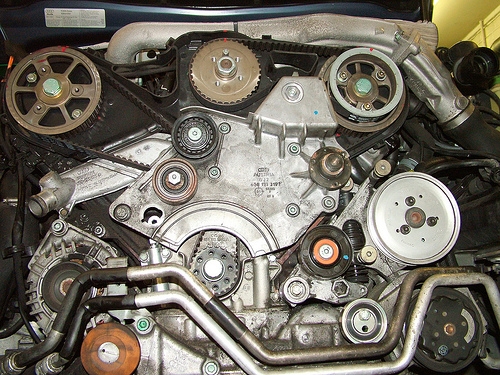
An engine power flush is a procedure in which a high-pressure solution is flushed into an automobile engine in order to clean out contaminants that could harm its performance. Performing engine power flushes at regular intervals could improve the auto's performance in areas of lubrication, engine performance and fuel economy, as well as extend the life of the vehicle.
The primary reason to perform a power flush is engine sludge, which is caused naturally by the use of gasoline and oil in your vehicle's engine. An oil filter, changed out at regular intervals, can help to lower the amount of sludge that builds up in the engine---but it won't prevent it. In fact, a half-quart of sludge remains in the engine when the oil is changed, which dirties the new oil just five miles after an oil change, according to autoprofit.com, which sells engine flush systems.
Autoprofit.com recommends an engine be flushed once every 15,000 miles, or once a year for an average driver. In many cases, the procedure can be done when you have your oil changed at your local service station.
First, technicians drain the engine of its oil and remove the oil filter. Coordinating your oil change and engine flush is recommended so money isn't wasted. The flush system machinery is connected to both the housing for the oil filter and the plug for the oil drain. Pressurized detergent is then injected into the system at high speed, which flushes and dissolves the sludge into an oil pan, where a vacuum sucks up the sludge.
Flushing the engine at regular intervals can have several benefits for the engine, according to autoprofit.com. Flushing can extend engine life and improve engine lubrication. Because sludge isn't clogging up the engine, the car can run cooler and the oil will last longer. Engine performance can improve, the car can run cleaner, and the knocks and pings associated with older or out-of-tune cars can stop. Fuel economy is also another possible benefit.
Before allowing technicians to service your engine, make sure they are informed about the flushing procedure. Ask questions such as how warm the solution will be (it should be around 110 degrees). Or you can request that your technician use a pressure machine that does not add pressure. Many machines work just as well when they are set to circulate detergent smoothly through the system. If the technician uses too much pressure or uses the machine improperly, there is a chance that it could cause damage to the engine, which could include blowing out the seals on important engine parts such as gaskets.